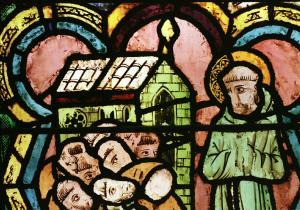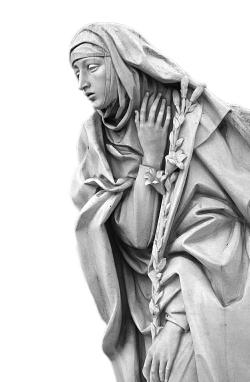Issue Date: April 4, 2003
From Hope to Hope Palm Sunday/Passion Sunday Scripture Readings By PAULO EVARISTO ARNS “From Hope to Hope.” This title that may seem strange to you is my episcopal motto. For me, hope has always been the most difficult of the theological virtues. Faith is a gift of God. Love sprouts from our hearts as we see the needs of others. But life is so full of contradictions that it is difficult to have hope and to grow in hope. Humanly speaking, there are moments in our lives when it is almost impossible to hope. Ernest Bloch sees hope as the stimulus and the impulse of all human endeavors. When we have hope, we reach for what is new, what never happened before, what we never even dreamed of. Hope is not the “opium of the people,” but the motor that changes the world. St. Paul tells us that our suffering produces perseverance; perseverance produces character and character produces hope. Hope never disappoints us (Romans 5). I feel that at this moment, in the life of the church worldwide, we are facing a crisis in hope. Our suffering, instead of leading us to perseverance and hope, is leading us to despair and indifference. There is no greater threat to any religion than indifference. I would like to begin my reflection for Palm Sunday with a story a friend told me. Her father was born in Italy and was viscerally anticlerical. He couldn’t understand why his engineer son went off to be a Dominican priest and his daughter worked full-time in her parish. One day he asked her to bring him a complete history of the Catholic church. She obeyed his wish even though she suspected that reading it would make him even more anticlerical. When she went to visit him again he told her: “My daughter, the church has to be of God. If it weren’t, it would have disappeared centuries ago.” This little story is at the heart of my reflection today. In the days of St. Francis of Assisi and St. Dominic Guzmán, the church faced scandals much worse than we are facing today. The saints did not become indifferent. Their suffering because of the evil they saw around them led them to react. Their perseverance and their courage gave them hope and inspired the whole church. What can we do today? Let’s return to the Second Vatican Council. Lumen Gentium, the “Dogmatic Constitution on the Church,” quotes St. Augustine’s sermon to the laity of his diocese: “When I am frightened by what I am to you, then I am consoled by what I am with you. To you I am the bishop; with you I am a Christian. The first is an office, the second is a grace; the first a danger, the second, salvation.” (n. 32) The document continues to say: “Lay people must be witnesses before the world to the resurrection and life of the Lord Jesus, they are the signs of the living God. All together, and each one, to the best of his or her ability, must nourish the world with spiritual fruits. … In a word: What the soul is to the body, let Christians be to the world!” (n. 38) We, all of us together, are the church. When some members suffer, we all suffer. But the central question for us today is the role of the laity in the institution of the church. We are all the body of Christ and in this body all the members are equal. This is not true of the institution. Vatican II hoped to change the relationships between the hierarchy and the people, between bishops and the pope, between the clergy and the people. The council did announce theoretical principles, but couldn’t renew the structure of the church. The council preached decentralization, but there has been more centralization. But in these last three or four decades there has been a fundamental change in the universal church. The demographic explosion in the last century had an important effect on the Catholic church. Until the middle of the 20th century the reality of the church depended on Western thought and culture. Today the churches of the North represent only 38 percent of the world’s Catholic population. This means that almost two thirds of all Catholics are in the Southern Hemisphere. Vatican II was the result of the hopes and aspirations of the church in the First World. Today Catholics and Protestants alike have more growing communities in the Third World. As my Jesuit friends like to say, there are now more Jesuits in India than in the United States. What will this mean for the future of the church? The fact that Catholic Europe and Catholic North America no longer represent the thinking and the hopes of the majority of Catholics worldwide will have a great effect if and when there is a “Vatican III.” When I became archbishop of São Paulo in 1971, one of my first projects was to have, every two years, an Assembly of the Church. We had two topics to discuss: What is the church doing right and how should we continue; and what is the church doing wrong and how should we change it? Everyone was invited to these assemblies. I wanted to open them to interested non-Catholics who live in the city and could analyze what we were doing from a different perspective. But some of my collaborators thought this was going a little too far. Some of my brother bishops accused me of “Protestantizing” the church. In the Catholic church, they told me, bishops decide, laity do! You who are reading this article cannot remain silent. Indifference is a cancer that destroys the body of Christ. We are the church! When there is suffering we have to react. Among you there must be a Francis, a Dominic, a Dorothy Day! As a church we have passed through thousands of Lents and also thousands of Easters! We have to learn to react not only with accusations and disgust, but also with vision and hope. As we asked in our assemblies: What are we doing wrong and how do we change it? No bishop can answer this alone. Until the middle of the 19th century, Rome nominated very few bishops. All this changed with the Code of Canon Law of 1917. The participation of the people of God in the choosing of their pastors had a long tradition. Lumen Gentium recognized that “the whole body of the faithful who have an anointing that comes from the Holy One cannot err in matters of belief.” (n. 12) We have a holy tradition of fraternal correction in the church. It started in Antioch when Paul corrected Peter for being afraid of James. In the Middle Ages, we have the example of Catherine of Siena. She told the pope of her day: “There are three things God requires of you. The first is to reform the church -- to pull up the bad herbs by the roots, that is to say, the bad pastors and governors who poison and corrupt the garden. … Be a man. Father, arise! No negligence! Do God’s will and mine!” It’s good to note that both Paul and Catherine are saints! When we act for reform because we love the church we grow in holiness.
I would like to end this reflection with a quote from the column of “Pastor Ignotus” in the British Catholic weekly The Tablet (Nov. 20, 2002). In an article about the pedophilia crisis and the immense suffering it has caused, he relates the results of what the laity has told him:
May God bless his good people and give them hope and courage during this Holy Week. As the Book of Revelation (7: 14 ff) reminds us: “These are the people who have come safely through the terrible tribulation. They have washed their robes and made them white with the blood of the Lamb. That is why they stand before God’s throne and serve him day and night. ... Never again will they hunger or thirst; neither sun or scorching heat will burn them, because the Lamb, who is in the center of the throne, will be their shepherd, and he will guide them to springs of life-giving water. And their God will wipe away every tear from their eyes!” Cardinal Paulo Evaristo Arns is the retired archbishop of São Paulo, Brazil. National Catholic Reporter, April 4, 2003 |

